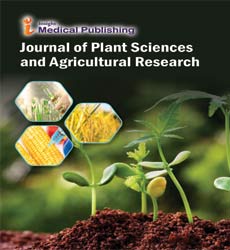Effects of Plant Breeding and Breeding Waste Composts on Crop Yields
Singh Longhi*
Department of Agronomy, University of São Paulo, Piracicaba, Brazil
- *Corresponding Author:
- Singh Longhi
Department of Agronomy, University of São Paulo, Piracicaba,
Brazil,
E-mail: longhi.s@gmail.com
Received date: November 22, 2024, Manuscript No. IPJPSAR-24-20183; Editor assigned date: November 25, 2024, PreQC No. IPJPSAR-24-20183 (PQ); Reviewed date: December 09, 2024, QC No. IPJPSAR-24-20183; Revised date: December 16, 2024, Manuscript No. IPJPSAR-24-20183 (R); Published date: December 23, 2024, DOI: 10.36648/ipjpsar.8.4.162
Citation: Longhi S (2024) Effects of Plant Breeding and Breeding Waste Composts on Crop Yields. J Plant Sci Agri Res Vol.8 No.4: 162.
Description
Plant breeding is a fundamental of modern agriculture, with its primary goal being to enhance the genetic potential of crops to increase yields, improve disease resistance and adapt plants to changing environmental conditions. Through selective breeding, plant breeders have successfully developed crop varieties that offer higher productivity, better nutritional profiles and greater resilience against pests and diseases. These improvements in crop yields are need for feeding a growing global population, particularly in the face of challenges such as climate change and limited arable land.
Effects of plant breeding on crop yields
One of the most significant contributions of plant breeding to agricultural productivity is the development of high-yielding varieties. Over the past century, breeders have used both traditional breeding techniques and more advanced genetic methods, such as genetic modification and genomic selection, to develop varieties with improved characteristics. For example, the green revolution of the mid-20th century was marked by the development of high-yielding wheat and rice varieties, which revolutionized food production in many parts of the world. These varieties were bred to respond well to fertilizers, water and other inputs, thus increasing their productivity per hectare.
In addition to increasing yield potential, plant breeding has also focused on improving resistance to biotic and abiotic stresses, which are key factors affecting crop performance. Crops are often vulnerable to diseases, pests, drought and extreme temperatures, all of which can negatively impact yields. Through breeding programs, crops such as corn, soybeans and wheat have been enhanced to withstand these challenges. For example, disease-resistant varieties of crops like rice and maize have been developed to combat specific pathogens, reducing the need for chemical pesticides and increasing yield stability.
Another important aspect of plant breeding is the development of crops with improved nutritional quality. In some cases, plant breeders have focused on improving the levels of need nutrients, such as vitamins, minerals and proteins, in the crops themselves. Golden rice, for example, has been genetically engineered to contain higher levels of provitamin A, addressing vitamin A deficiency in regions where rice is a staple food. Similarly, breeders have developed wheat varieties with improved protein content to improve the nutritional value of bread and other wheat-based products.
While plant breeding has led to substantial increases in crop yields, it is not without its challenges. The success of breeding programs depends on a variety of factors, including the availability of genetic diversity, funding and the ability to address new emerging threats such as climate change and novel pests. Moreover, the environmental impact of breeding new varieties, including concerns about soil health, biodiversity and water use, must also be considered.
Effects of breeding waste composts on crop yields
While plant breeding focuses on improving the genetic traits of crops, breeding waste composts offer a sustainable and organic approach to improving soil fertility and crop productivity. Breeding waste, which includes plant residues, by-products from seed production and other organic matter generated during the breeding process, can be recycled and transformed into compost. This compost, when applied to soils, provides a rich source of organic matter, need nutrients and beneficial microorganisms that can enhance crop growth and yields.
In addition to enhancing soil fertility, breeding waste composts can help increase soil microbial diversity. The microorganisms present in compost, including bacteria, fungi and earthworms, play an important role in decomposing organic matter, cycling nutrients and protecting plants from pathogens. By introducing these beneficial microbes into the soil, compost can help maintain a healthy soil ecosystem that supports plant health and growth. Furthermore, some studies have shown that the application of composted organic matter can help suppress soil-borne diseases, as certain microbes in the compost act antagonistically to harmful pathogens.
Another benefit of using breeding waste composts is that they contribute to sustainability in agriculture. By recycling organic waste products from breeding programs, composting helps reduce the environmental impact of waste disposal while improving soil health. Composting also reduces the need for synthetic fertilizers, which can be costly and have negative environmental effects, such as nutrient leaching and water pollution. Furthermore, compost can help sequester carbon in the soil, contributing to efforts to mitigate climate change by reducing greenhouse gas emissions.
Research has shown that the application of breeding waste composts can have positive effects on crop yields. For example, studies have demonstrated that composted organic matter increases the yields of crops such as tomatoes, lettuce and wheat by enhancing soil quality and providing a steady supply of nutrients. In some cases, compost application has been found to improve crop yields more effectively than conventional fertilizers, particularly in soils that are deficient in organic matter. The slow-release nature of composted nutrients means that crops can access the nutrients they need over an extended period, reducing the risk of nutrient imbalances or leaching.
Open Access Journals
- Aquaculture & Veterinary Science
- Chemistry & Chemical Sciences
- Clinical Sciences
- Engineering
- General Science
- Genetics & Molecular Biology
- Health Care & Nursing
- Immunology & Microbiology
- Materials Science
- Mathematics & Physics
- Medical Sciences
- Neurology & Psychiatry
- Oncology & Cancer Science
- Pharmaceutical Sciences
